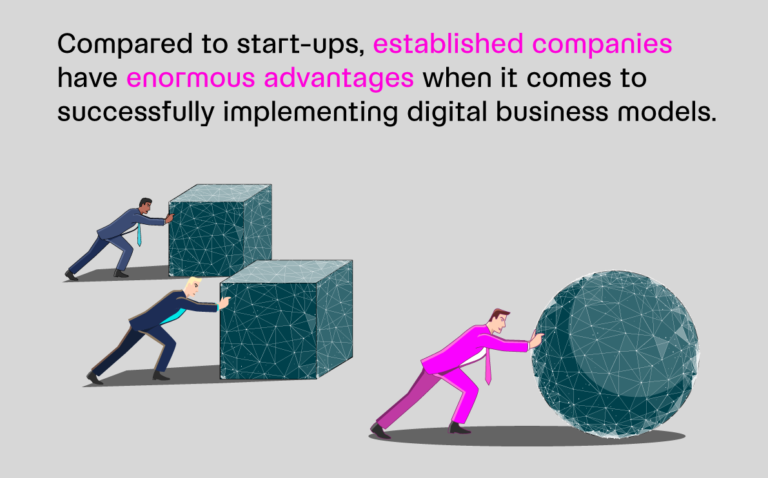Traditional companies fear the disruption of their industries trough digital business models. We have already learned this in our article “What is a digital business model?”. But what kind of digital business models actually exist? In the following, we will introduce you to tried and tested business concepts for digital transformation – with some specific examples!
Business Model 1: Free
Companies offer a product or service free of charge. We have many prominent examples of this – from search engines like Google to social networks like Facebook to mobile apps like Angry Birds. The idea behind it? Monetisation is easier to achieve once users have become accustomed to the product or service!
Monetisation can then be achieved in the following ways, for example:
- A free basic version and a paid premium version of the product or service
- One target group receives the service or product for free, the other target group pays for it
- Free product or service, but paid training materials, further training or information products
Business Model 2: Freemium
A Freemium can work similarly to a Free model. Companies make a product or service with limited functionality available free of charge – and try to persuade the user to subscribe to a paid subscription within these free services. This allows for customer acquisition with minimal advertising!
A freemium is particularly suitable for products and services with a potentially large reach: Dropbox, MailChimp, Spotify and numerous mobile apps are successful examples of a freemium model. Spotify, for example, offers its music streaming service for free with advertising. If users opt for the premium service, they can listen to music and download music for offline use without advertising breaks.
Business Model 3: Open Source
An open source model not only makes software freely accessible; it also offers its users the opportunity to actively participate in the product. This can quickly lead to a high reach – but in the end it is the collaborative work on the product that decides on success.
Monetisation can be difficult with an open source product. Companies like Red Hat, for example, earn their money by charging premium subscriptions for training and services related to their open source software.
Another popular example of this digital business model is GitHub.
Business Model 4: E-Commerce
E-commerce companies are among the most popular (and largest) digital business models. Amazon, eBay, Zalando or Alibaba, all of these online marketplaces offer various providers a central platform for offering products and services at competitive prices. For each sale, the e-commerce platforms then earn a commission.
Tip: A successful online marketplace scores points with its users with various factors such as reliability, buyer protection or free delivery.
Business Model 5: On-Demand
Waiting all day for your favourite film to finally start? That is a thing of the past! Nowadays, we consume content at our own pace and according to our own schedule, which is made possible by so-called on-demand services.
Netflix, in particular, has made this model popular. Our favourite programmes and films can be accessed on the platform at any time. Services such as Uber or Lyft also use the on-demand model and have thus revolutionised public transport. Just as AirBnB has revolutionised the hotel industry with on-demand accommodation. What do they all have in common? They use digital platforms to enable people to interact and communicate directly with each other from anywhere.
If you want to be successful as an on-demand business, it is imperative that you offer your users a flawless user experience. It must be as simple as possible!
Business Model 6: Subscriptions
Amazon Prime, Netflix or Salesforce – there are countless successful companies that rely on subscriptions for their digital business model. How does that work? Instead of buying a product or service once, customers pay a monthly or annual fee for regular use.
The advantages for companies are evident:
- A loyal user base
- Continuous income
- Plannable and predictable sales pipeline
You should bear in mind that regular updates are inevitable in order to bind customers to the service or product in the long term. The work never stops! Companies like Spotify or Netflix spend millions of Euros every year to produce original content – and to get subscribers to renew their plan.
Business Model 7: Advertising
Of course, you can also rely on advertising for your digital business model. Numerous companies do this – from online newspapers and magazines, Google and Quora to Facebook, Twitter or Instagram. Google, for example, makes almost all its services and apps available free of charge. On the other hand, Google monetizes the data collected via its search engine with an advertising network called AdWords (now called Google Ads).
Important: If you do not dominate the market like Google or Facebook, you will hardly make enough money from advertising alone. Unless you have an exceptionally large user base!
Business Model 8: Peer-to-Peer (P2P)
A P2P network is a decentralised platform where two parties participate in a transaction. Users can use the platform to buy or sell goods or services, for example, and communicate directly with each other (without a third party). Popular examples of this digital business model include Craigslist, Airbnb, Etsy, Uber, Airbnb, LinkedIn.
The biggest challenge in peer-to-peer business is the interdependence of supply and demand. Firstly, you need sufficient demand to attract more providers to your platform. On the other hand, you also need enough providers to generate demand.
Business Model 9: Hidden Revenue
Hidden revenue refers to the generation of revenue while the users of the product or service hardly notice it. Facebook and Google are two wonderful examples of this. The average Facebook or Google user does not know how the companies earn their money.
How does such a business model succeed? The core service must be free of charge for the general public. Many hidden revenue companies must also invest a lot of resources to make the model work.
Digital Business Models:
Conclusion & an important tip
Whether through on-demand, freemium or subscriptions; anyone wishing to make a digital start can choose from many tried and tested business models. However, if you take a look at our examples, you will see that almost all the companies we have mentioned combine at least two digital business models. For example, Airbnb and Uber are both on-demand and peer-to-peer marketplaces.
As with cooking, the wow effect is often only created by combining different ingredients in a unique formula. However, years can pass before this happens (as with Google, for example) – or you can use our expertise to take shortcuts and speed up your digital transformations. Please feel free to send us a message and get free advice. We are looking forward to you!




